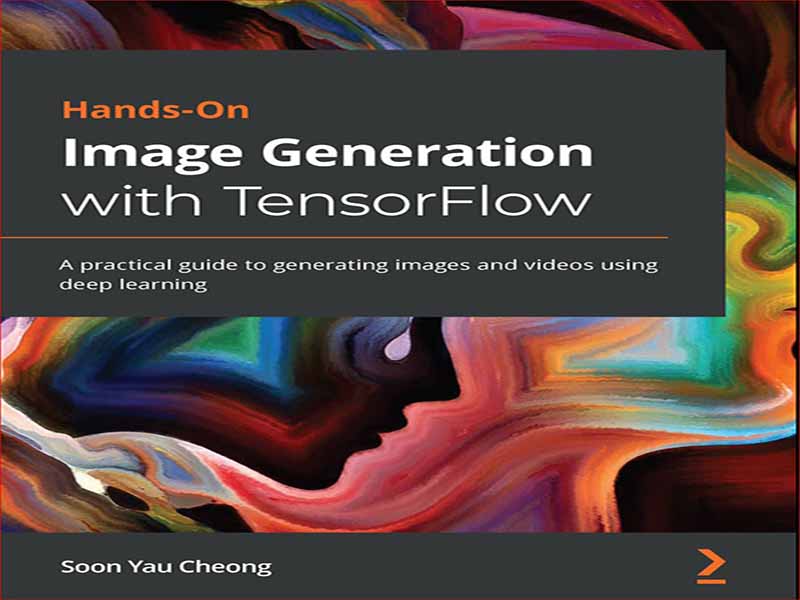- عنوان کتاب: Hands-On Image Generation with TensorFlow
- نویسنده: Soon Yau Cheong
- حوزه: یادگیری عمیق
- سال انتشار: 2020
- تعداد صفحه: 253
- زبان اصلی: انگلیسی
- نوع فایل: pdf
- حجم فایل: 13.4 مگابایت
این کتاب برای مهندسین، پزشکان و محققانی است که دانش پایه در مورد شبکههای عصبی کانولوشنال دارند و میخواهند از آن برای یادگیری تکنیکهای مختلف تولید تصویر با استفاده از TensorFlow 2.x استفاده کنند. همچنین اگر یک مهندس حرفه ای پردازش تصویر یا بینایی کامپیوتر هستید که به دنبال کشف معماری های پیشرفته برای بهبود و بهبود تصاویر و ویدیوها هستید، این کتاب برای شما مفید خواهد بود. برای به دست آوردن بهترین نتیجه از کتاب، دانش Python و TensorFlow لازم است. آموزش های آنلاین زیادی برای آموزش اصول GAN وجود دارد. با این حال، مدلها نسبتاً ساده هستند و فقط برای مجموعه دادههای اسباببازی مناسب هستند. در انتهای دیگر طیف، کدهای رایگان نیز برای مدل های پیشرفته برای تولید تصاویر واقعی وجود دارد. با این وجود، کد پیچیده است و فقدان توضیح، درک آن را برای مبتدیان دشوار می کند. بسیاری از «کلونرهای Git» که این کدها را دانلود کردند، هیچ سرنخی نداشتند که چگونه مدلها را تغییر دهند تا برای برنامههایشان کار کنند. این کتاب قصد دارد این شکاف را پر کند. ما با یادگیری اصول اولیه شروع می کنیم و بلافاصله کد را پیاده سازی می کنیم تا آنها را آزمایش کنیم. شما می توانید فوراً نتیجه کار خود را ببینید. تمام کدهای لازم برای ساخت یک مدل در یک دفترچه یادداشت Jupyter گذاشته شده است. این به این منظور است که عبور از جریان کد را برای شما آسانتر کرده و کد را به صورت تعاملی تغییر داده و آزمایش کنید. من معتقدم نوشتن از ابتدا بهترین راه برای یادگیری و تسلط بر یادگیری عمیق است. در هر فصل بین یک تا سه مدل وجود دارد که همه آنها را از ابتدا می نویسیم. وقتی این کتاب را تمام کردید، نه تنها با تولید تصویر آشنا خواهید شد، بلکه در TensorFlow 2 نیز متخصص خواهید بود. فصل ها تقریباً به ترتیب زمانی تاریخ GAN ها مرتب شده اند، جایی که فصل ها ممکن است بر اساس دانش فصل های قبلی باشد. . بنابراین بهتر است فصول را به ترتیب مطالعه کنید، مخصوصاً سه فصل اول که مبانی را در بر می گیرد. پس از آن، ممکن است به فصل هایی بروید که بیشتر مورد علاقه شما هستند. اگر در حین مطالعه با کلمات اختصاری گیج شده اید، می توانید به خلاصه تکنیک های GAN که در فصل آخر ذکر شده است مراجعه کنید.
This book is for deep learning engineers, practitioners, and researchers who have basic knowledge of convolutional neural networks and want to use it to learn various image generation techniques using TensorFlow 2.x. You’ll also find this book useful if you are an image processing professional or computer vision engineer looking to explore state-of-the-art architectures to improve and enhance images and videos. Knowledge of Python and TensorFlow is required to get the best out of the book. There are many online tutorials available teaching the basics of GANs. However, the models tend to be rather simple and suitable only for toy datasets. At the other end of the spectrum, there are also free codes available for state-of-the-art models to generate realistic images. Nevertheless, the code tends to be complex, and the lack of explanation makes it difficult for beginners to understand. Many of the “Git cloners” who downloaded the codes had no clue how to tweak the models to make them work for their applications. This book aims to bridge that gap. We will start with learning the basic principles and immediately implement the code to put them to the test. You’ll be able to see the result of your work instantly. All the necessary code to build a model is laid bare in a single Jupyter notebook. This is to make it easier for you to go through the flow of the code and to modify and test the code in an interactive manner. I believe writing from scratch is the best way to learn and master deep learning. There are between one to three models in each chapter, and we will write all of them from scratch. When you finish this book, not only will you be familiar with image generation but you will also be an expert in TensorFlow 2. The chapters are arranged in roughly chronological order of the history of GANs, where the chapters may build upon knowledge from previous chapters. Therefore, it is best to read the chapters in order, especially the first three chapters, which cover the fundamentals. After that, you may jump to chapters that interest you more. Should you feel confused by the acronyms during the reading, you can refer to the summary of GAN techniques listed in the last chapter.
این کتاب را میتوانید بصورت رایگان از لینک زیر دانلود نمایید.



































نظرات کاربران